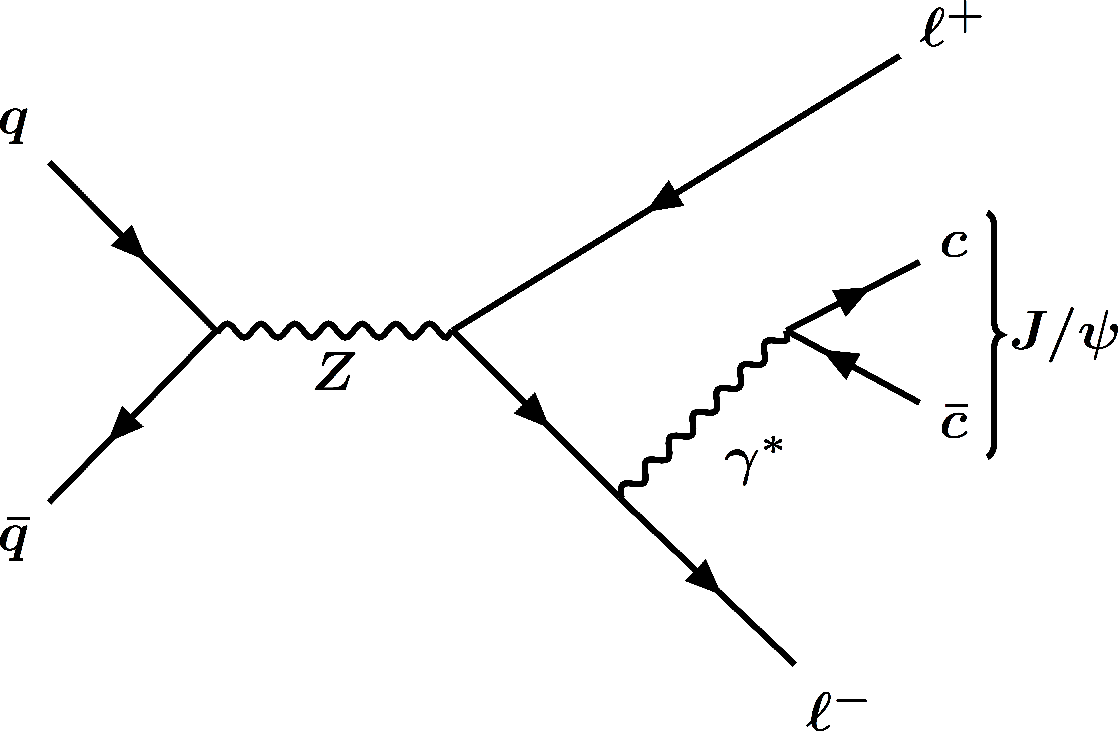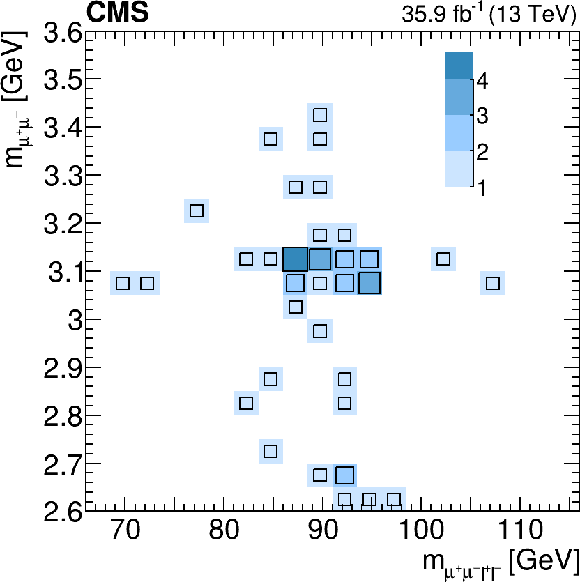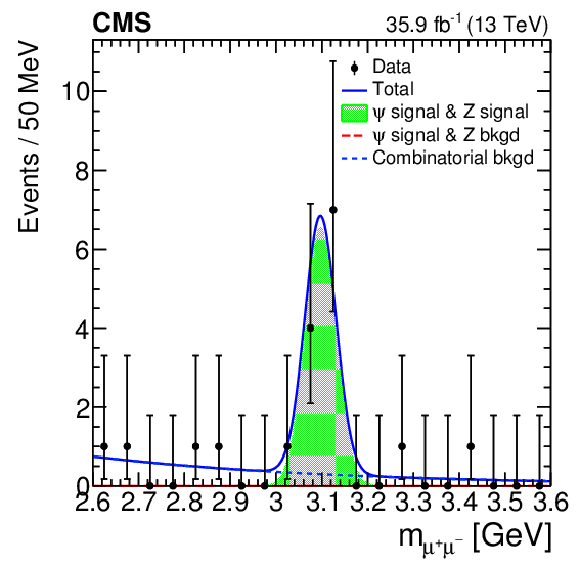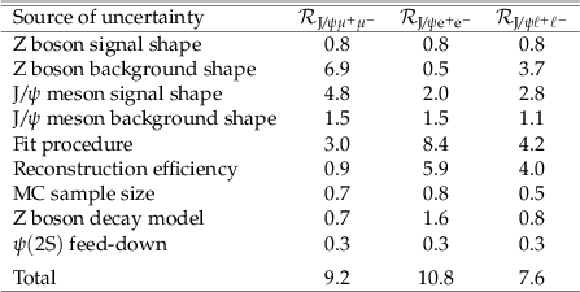

Compact Muon Solenoid
LHC, CERN
| CMS-BPH-16-001 ; CERN-EP-2018-131 | ||
| Observation of the $\mathrm{Z} \to \psi \ell^{+} \ell^{-}$ decay in pp collisions at $\sqrt{s} = $ 13 TeV | ||
| CMS Collaboration | ||
| 11 June 2018 | ||
| Phys. Rev. Lett. 121 (2018) 141801 | ||
| Abstract: This Letter presents the observation of the rare Z boson decay $\mathrm{Z} \to \psi \ell^{+} \ell^{-}$. Here, $\psi$ represents contributions from direct $ \mathrm{J}/\psi$ and $\psi\mathrm{(2S)}\to\mathrm{J}/\psi\,X$, ${\ell^+\ell^-} $ is a pair of electrons or muons, and the $ \mathrm{J}/\psi$ meson is detected via its decay to ${\mu^{+}\mu^{-}} $. The sample of proton-proton collision data, collected by the CMS experiment at the LHC at a center-of-mass energy of 13 TeV, corresponds to an integrated luminosity of 35.9 fb$^{-1}$. The signal is observed with a significance in excess of 5 standard deviations. After subtraction of the $\psi\mathrm{(2S)}\to\mathrm{J}/\psi\,X$ contribution, the ratio of the branching fraction of the exclusive decay $\mathrm{Z} \to \mathrm{J}/\psi \ell^{+} \ell^{-}$ to the decay $\mathrm{Z} \to \mu^{+}\mu^{-}\mu^{+}\mu^{-}$ within a fiducial phase space is measured to be $\mathcal{B}(\mathrm{Z} \to \mathrm{J}/\psi \ell^{+} \ell^{-}) / \mathcal{B}(\mathrm{Z} \to \mu^{+}\mu^{-}\mu^{+}\mu^{-}) = $ 0.67 $\pm$ 0.18 (stat) $\pm$ 0.05 (syst). | ||
| Links: e-print arXiv:1806.04213 [hep-ex] (PDF) ; CDS record ; inSPIRE record ; HepData record ; CADI line (restricted) ; | ||
| Figures | |

png pdf |
Figure 1:
Feynman diagram for the dominant production process and leading-order decay of the $ {{\mathrm {Z}}\to \mathrm{J}/\psi\ell ^+\ell ^-} $. |

png pdf |
Figure 2:
Distribution of invariant masses $m_{{{{\mu ^+}} {{\mu ^-}}}}$ vs. $m_{{{{\mu ^+}} {{\mu ^-}}} {\ell ^+\ell ^-}}$ for the selected candidates. The values in the legend give the numbers of candidates per bin. |

png pdf |
Figure 3:
Invariant mass distributions for the $\psi $ muon pairs (left) and for ${\psi \,\ell ^+\ell ^-}$ (right), for ${{\mathrm {Z}}\to \psi \, {{\mu ^+}} {{\mu ^-}}}$ (upper) and ${{\mathrm {Z}}\to \psi \, {\mathrm {e}^+} {\mathrm {e}^-}} $ (lower) candidates. In each histogram the data are represented by the points, with the vertical bars showing the statistical uncertainties, and the solid curve is the overall fit to the data. The shaded region corresponds to the signal yield, while the dashed lines are the $\psi $ meson signal from the Z boson background (left) and the Z boson signal from the $\psi $ meson background (right). The dotted line represents the combinatorial background. |

png pdf |
Figure 3-a:
Invariant mass distribution for the $\psi $ muon pairs, for ${{\mathrm {Z}}\to \psi \, {{\mu ^+}} {{\mu ^-}}}$ candidates. The data are represented by the points, with the vertical bars showing the statistical uncertainties, and the solid curve is the overall fit to the data. The shaded region corresponds to the signal yield, while the dashed lines are the $\psi $ meson signal from the Z boson background. The dotted line represents the combinatorial background. |

png pdf |
Figure 3-b:
Invariant mass distribution for ${\psi \,\ell ^+\ell ^-}$, for ${{\mathrm {Z}}\to \psi \, {{\mu ^+}} {{\mu ^-}}}$ candidates. The data are represented by the points, with the vertical bars showing the statistical uncertainties, and the solid curve is the overall fit to the data. The shaded region corresponds to the signal yield, while the dashed lines are the Z boson signal from the $\psi $ meson background. The dotted line represents the combinatorial background. |

png pdf |
Figure 3-c:
Invariant mass distribution for the $\psi $ muon pairs, for ${{\mathrm {Z}}\to \psi \, {\mathrm {e}^+} {\mathrm {e}^-}} $ candidates. The data are represented by the points, with the vertical bars showing the statistical uncertainties, and the solid curve is the overall fit to the data. The shaded region corresponds to the signal yield, while the dashed lines are the $\psi $ meson signal from the Z boson background. The dotted line represents the combinatorial background. |

png pdf |
Figure 3-d:
Invariant mass distribution for ${\psi \,\ell ^+\ell ^-}$, for ${{\mathrm {Z}}\to \psi \, {\mathrm {e}^+} {\mathrm {e}^-}} $ candidates. The data are represented by the points, with the vertical bars showing the statistical uncertainties, and the solid curve is the overall fit to the data. The shaded region corresponds to the signal yield, while the dashed lines are the Z boson signal from the $\psi $ meson background. The dotted line represents the combinatorial background. |
| Tables | |

png pdf |
Table 1:
Definition of the fiducial phase space for the measurement of the ratio of branching fractions. Here, $\ell $ refers to a prompt muon or electron from the signal decay, or to either of the two muons from the higher invariant-mass pair in the reference-channel decay, and ${{\mu}}$ refers to a $ \mathrm{J}/\psi$ daughter or a member of the lower invariant-mass pair in the reference-channel decay. The symbol $\ell _1$ ($\ell _2$) refers to the prompt lepton having the higher (lower) value of ${p_{\mathrm {T}}}$. The $ {p_{\mathrm {T}}} ^{\mathrm{J}/\psi}$ threshold is applied to the signal and the $m({{\mu} ^\pm {{\mu}}^\mp})$ requirement to the reference channel. |

png pdf |
Table 2:
The contributions to the systematic uncertainty in the ratio of branching fractions for the prompt muon, prompt electron, and combined samples, in percent. The last row gives the sum in quadrature of all components. |
| Summary |
| In summary, a new decay mode of the Z boson into a $\psi$ meson, where $\psi$ represents the contributions from direct $ \mathrm{J}/\psi$ and $\psi\to\mathrm{J}/\psi\,X$, and an additional pair of leptons (muons or electrons), is observed with a statistical significance greater than 5 standard deviations. Using data from proton-proton collisions collected with the CMS detector at $\sqrt{s}= $ 13 TeV, corresponding to an integrated luminosity of 35.9 fb$^{-1}$, 13.0 $\pm$ 3.9 events of the $\mathrm{Z} \to \mu^{+}\mu^{-}$ and 11.2 $\pm$ 3.4 events of the $\mathrm{Z} \to \mathrm{e^{+}e^{-}}$ decay are obtained. This is the first observed Z boson decay to a vector meson and two oppositely charged same-flavor leptons. The ratio of the branching fraction for this decay to the one for the reference channel $\mathrm{Z} \to \mu^{+}\mu^{-}\mu^{+}\mu^{-}$ in the fiducial phase space of the measurement, as defined in Table 1, after subtracting the $\psi$ feed-down, is $\mathcal{R}_{\mathrm{J}/\psi\,\ell^{+} \ell^{-}} = $ 0.67 $\pm$ 0.18 (stat) $\pm$ 0.05 (syst). Using the known branching fraction for $\mathrm{Z} \to \mu^{+}\mu^{-}\mu^{+}\mu^{-}$ results in a branching fraction for $\mathrm{Z} \to \mathrm{J}/\psi \ell^{+} \ell^{-}$ consistent with standard model predictions. |
| References | ||||
| 1 | UA1 Collaboration | Experimental observation of lepton pairs of invariant mass around $ 95 \mathrm{GeV}/\mathrm{c}^2 $ at the CERN SPS collider | PLB 126 (1983) 398 | |
| 2 | CMS Collaboration | Observation of $ \mathrm{Z} $ decays to four leptons with the CMS detector at the LHC | JHEP 12 (2012) 034 | CMS-SMP-12-009 1210.3844 |
| 3 | CMS Collaboration | Measurement of the ZZ production cross section and Z $ \to \ell^+\ell^-\ell'^+\ell'^- $ branching fraction in pp collisions at $ \sqrt{s}=13 \mathrm{TeV} $ | PLB 763 (2016) 280 | CMS-SMP-16-001 1607.08834 |
| 4 | CMS Collaboration | Measurements of the $ \mathrm {p}\mathrm {p}\rightarrow \mathrm{Z}\mathrm{Z} $ production cross section and the $ \mathrm{Z}\rightarrow 4\ell $ branching fraction, and constraints on anomalous triple gauge couplings at $ \sqrt{s}=13 \mathrm{TeV} $ | EPJC 78 (2018) 165 | CMS-SMP-16-017 1709.08601 |
| 5 | ATLAS Collaboration | Measurements of four-lepton production at the $ \mathrm{Z} $ resonance in pp collisions at $ \sqrt{s}= $ 7 and $ 8 \mathrm{TeV} $ with ATLAS | PRL 112 (2014) 231806 | 1403.5657 |
| 6 | ATLAS Collaboration | Measurements of four-lepton production in pp collisions at $ \sqrt{s}= $ 8 TeV with the ATLAS detector | PLB 753 (2016) 552 | 1509.07844 |
| 7 | OPAL Collaboration | A measurement of photon radiation in lepton pair events from $ \mathrm{Z} $ decays | PLB 273 (1991) 338 | |
| 8 | ATLAS Collaboration | Search for Higgs and $ \mathrm{Z} $ boson decays to $ \mathrm{J}/\psi\gamma $ and $ \Upsilon\mathrm{(nS)}\gamma $ with the ATLAS detector | PRL 114 (2015) 121801 | 1501.03276 |
| 9 | ATLAS Collaboration | Search for exclusive Higgs and $ \mathrm{Z} $ boson decays to $ \phi\gamma $ and $ \rho\gamma $ with the ATLAS detector | Submitted to \it JHEP | 1712.02758 |
| 10 | L. Bergstrom and R. W. Robinett | $ \mathrm{Z} $ decay into a vector meson and a lepton pair | PLB 245 (1990) 249 | |
| 11 | S. Fleming | Electromagnetic production of quarkonium in $ \mathrm{Z} $ decay | PRD 48 (1993) 1914 | hep-ph/9304270 |
| 12 | S. Fleming | $ \mathrm{J}/\psi $ production from electromagnetic fragmentation in $ \mathrm{Z} $ decay | PRD 50 (1994) 5808 | hep-ph/9403396 |
| 13 | R. Li and J.-X. Wang | The next-to-leading-order QCD correction to inclusive $ \mathrm{J}/\psi(\Upsilon) $ production in $ \mathrm{Z} $ decay | PRD 82 (2010) 054006 | 1007.2368 |
| 14 | E. Braaten, K. Cheung, and T. C. Yuan | $ \mathrm{Z} $ decay into charmonium via charm quark fragmentation | PRD 48 (1993) 4230 | hep-ph/9302307 |
| 15 | P. Ernstrom, L. Lonnblad, and M. Vanttinen | Evolution effects in $ \mathrm{Z} $ fragmentation into charmonium | Z. Phys. C 76 (1997) 515 | hep-ph/9612408 |
| 16 | L. Bergstrom and R. W. Robinett | On the rare decays $ \mathrm{Z} \to \mathrm{V V} $ and $ \mathrm{Z} \to \mathrm{V P} $ | PRD 41 (1990) 3513 | |
| 17 | Particle Data Group | Review of particle physics | CPC 40 (2016) 100001 | |
| 18 | M. N. Doroshenko, V. G. Kartvelishvili, E. G. Chikovani, and S. M. Esakiya | Vector quarkonium in decays of heavy Higgs particles | Yad. Fiz. 46 (1987) 864.[\it Sov. J. NP 46 (1987) 493] | |
| 19 | D.-N. Gao | A note on Higgs decays into $ \mathrm{Z} $ boson and $ \mathrm{J}/\psi( \Upsilon $) | PLB 737 (2014) 366 | 1406.7102 |
| 20 | M. Gonzalez-Alonso and G. Isidori | The $ h \to 4l $ spectrum at low $ m_{34} $: Standard model vs. light new physics | PLB 733 (2014) 359 | 1403.2648 |
| 21 | CMS Collaboration | Performance of CMS muon reconstruction in $ {\mathrm{p}}{\mathrm{p}}\ $ collision events at $ \sqrt{s}=7 \mathrm{TeV} $ | JINST 7 (2012) P10002 | CMS-MUO-10-004 1206.4071 |
| 22 | CMS Collaboration | Performance of electron reconstruction and selection with the CMS detector in proton-proton collisions at $ \sqrt{s} = 8 \mathrm{TeV} $ | JINST 10 (2015) P06005 | CMS-EGM-13-001 1502.02701 |
| 23 | CMS Collaboration | The CMS experiment at the CERN LHC | JINST 3 (2008) S08004 | CMS-00-001 |
| 24 | S. Frixione, P. Nason, and C. Oleari | Matching NLO QCD computations with parton shower simulations: the $ POWHEG $ method | JHEP 11 (2007) 070 | 0709.2092 |
| 25 | T. Sjostrand, S. Mrenna, and P. Skands | A brief introduction to PYTHIA 8.1 | CPC 178 (2008) 852 | 0710.3820 |
| 26 | T. Sjostrand et al. | An introduction to PYTHIA 8.2 | CPC 191 (2015) 159 | 1410.3012 |
| 27 | CMS Collaboration | Event generator tunes obtained from underlying event and multiparton scattering measurements | EPJC 76 (2016) 155 | CMS-GEN-14-001 1512.00815 |
| 28 | NNPDF Collaboration | Parton distributions for the LHC Run II | JHEP 04 (2015) 040 | 1410.8849 |
| 29 | GEANT4 Collaboration | GEANT4 --- a simulation toolkit | NIMA 506 (2003) 250 | |
| 30 | M. Cacciari, G. P. Salam, and G. Soyez | The anti-$ {k_{\mathrm{T}}} $ jet clustering algorithm | JHEP 04 (2008) 063 | 0802.1189 |
| 31 | M. Cacciari, G. P. Salam, and G. Soyez | FastJet user manual | EPJC 72 (2012) 1896 | 1111.6097 |
| 32 | R. J. Barlow | Extended maximum likelihood | NIMA 297 (1990) 496 | |
| 33 | R. A. Fisher | Questions and Answers $ \#14 $ | Amer. Statis. 2 (1948) 30 | |
| 34 | M. J. Oreglia | A study of the reactions $\psi' \to \gamma\gamma \psi$ | PhD thesis, Stanford University, 1980 SLAC Report SLAC-R-236, see A | |
| 35 | CMS Collaboration | Measurements of inclusive $ \mathrm{W} $ and $ \mathrm{Z} $ cross sections in $ \mathrm{pp} $ collisions at $ \sqrt{s}=7 \mathrm{TeV} $ | JHEP 01 (2011) 080 | CMS-EWK-10-002 1012.2466 |
| 36 | M. Pivk and F. R. Le Diberder | $ _{s}\mathcal{P}lot $: A statistical tool to unfold data distributions | NIMA 555 (2005) 356 | physics/0402083 |
| 37 | P. Faccioli, C. Louren\cco, J. Seixas, and H. K. Wohri | Towards the experimental clarification of quarkonium polarization | EPJC 69 (2010) 657 | 1006.2738 |

|
Compact Muon Solenoid LHC, CERN |

|

|

|

|

|

|